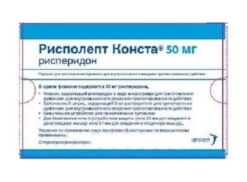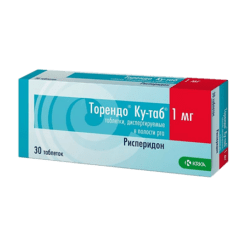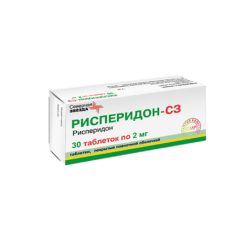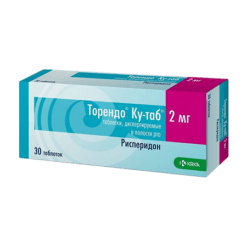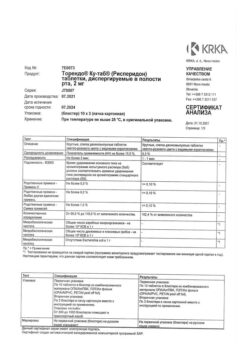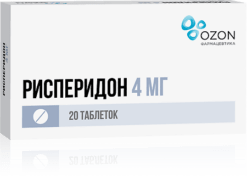No products in the cart.
Risperidone, 2 mg 20 pcs
€7.85 €6.87
Out of stock
(E-mail when Stock is available)
Description
Risperidone is an antipsychotic (neuroleptic), a benzisoxazole derivative. It also has sedative, antiemetic and hypothermic effects. Selective monoaminergic antagonist, has high tropism to serotonergic 5-HT2 and dopaminergic D2 receptors. It also binds to alpha1-adrenoreceptors with slightly lower affinity to H1-histaminergic and alpha2-adrenergic receptors. It has no tropinity to cholinoreceptors.
Antipsychotic action is caused by blockade of dopamine D2-receptors of mesolimbic and mesocortical system. Sedative action is caused by blockade of adrenoreceptors of reticular formation of brain stem; antiemetic action – by blockade of dopamine D2-receptors of trsternal zone of vomiting center; hypothermic action – by blockade of dopamine receptors of hypothalamus.
Suppresses productive symptomatology (delirium, hallucinations, aggression), automatism. Causes less suppression of motor activity and is less likely to induce catalepsy than classical antipsychotic drugs (neuroleptics). Balanced central antagonism to serotonin and dopamine may reduce the propensity for extrapyramidal side effects and extend the therapeutic effects of the drug to include negative and affective symptoms of schizophrenia.
May induce a dose-dependent increase in plasma prolactin concentration.
Pharmacokinetics
Absorption is rapid and complete. Food has no effect on the completeness and rate of absorption. ÒCmax of risperidone is 1 hour, of 9-hydroxyrisperidone – 3 hours (with high activity of CYP2D6 isoenzyme) and 17 hours (with low activity of CYP2D6 isoenzyme). Plasma concentrations of risperidone are proportional to the dose of the drug. The equilibrium concentration of risperidone in most patients is reached within 1 day, 9-hydroxy-risperidone – after 4-5 days.
Risperidone is rapidly distributed in the body. It penetrates the central nervous system (CNS), breast milk. The volume of distribution is 1-2 l/kg. Binding with plasma proteins (with alpha1-acid glycoprotein and albumin) of risperidone is 90%, that of 9-hydroxyrisperidone – 77%.
It is metabolized by CYP2D6 isoenzyme to the active metabolite, 9-hydroxysperidone (risperidone and 9-hydroxysperidone constitute the active antipsychotic fraction). Another route of metabolism of risperidone is N-dealkylation.
The half-life of risperidone is 3 hours; 9-hydroxyrisperidone and the active antipsychotic fraction is 20-24 hours.
Excreted by the kidneys (70%: of which 35-45% – as pharmacologically active fraction) and intestines (14%).
The study of single administration of the drug showed higher plasma concentration and slower excretion in elderly patients and patients with renal insufficiency. Excretion is slower in elderly patients and in patients with renal failure.
In case of hepatic impairment plasma content of risperidone is increased by 35%.
Indications
Indications
schizophrenia (acute and chronic) and other psychotic conditions with productive and/or negative symptoms;
affective disorders in various mental illnesses;
behavioral disorders in patients with dementia with symptoms of aggressiveness (outbursts of anger, physical violence), mental disorders (agitation, delusions) or psychotic symptoms;
as an adjuvant therapy in the treatment of mania in bipolar disorders;
as an auxiliary therapy for behavioral disorders in adolescents over 15 years of age and adult patients with a reduced intellectual level or mental retardation, in cases where destructive behavior (aggression, impulsivity, self-aggression) is leading in the clinical picture of the disease.
Pharmacological effect
Pharmacological effect
Risperidone is an antipsychotic drug (neuroleptic), a derivative of benzisoxazole. It also has a sedative effect. antiemetic and hypothermic effect. A selective monoaminergic antagonist with high affinity for serotonergic 5-HT2 and dopaminergic D2 receptors. It also binds to alpha1-adrenergic receptors with slightly lower affinity to H1-histaminergic and alpha2-adrenergic receptors. Does not have tropism for cholinergic receptors.
The antipsychotic effect is due to the blockade of dopamine D2 receptors of the mesolimbic and mesocortical systems. The sedative effect is due to the blockade of adrenergic receptors in the reticular formation of the brain stem; antiemetic effect – blockade of dopamine D2 receptors in the trilateral zone of the vomiting center; hypothermic effect – blockade of dopamine receptors of the hypothalamus.
Suppresses productive symptoms (delusions, hallucinations, aggressiveness), automatism. Causes less suppression of motor activity and induces catalepsy to a lesser extent than classical antipsychotic drugs (neuroleptics). Balanced central antagonism of serotonin and dopamine may reduce the propensity for extrapyramidal side effects and expand the therapeutic effect of the drug to cover the negative and affective symptoms of schizophrenia.
May induce a dose-dependent increase in plasma prolactin concentrations.
Pharmacokinetics
Absorption is fast and complete. Food does not affect the completeness and speed of absorption. Tmax of risperidone – 1 hour, 9-hydroxyrisperidone – 3 hours (with high activity of the CYP2D6 isoenzyme) and 17 hours (with low activity of the CYP2D6 isoenzyme). Plasma concentrations of risperidone are proportional to the dose of the drug. The equilibrium concentration of risperidone in most patients is achieved within 1 day, 9-hydroxy-risperidone – after 4-5 days.
Risperidone is rapidly distributed in the body. Penetrates into the central nervous system (CNS), breast milk. Volume of distribution 1-2 l/kg. Plasma protein binding (with alpha1-acid glycoprotein and albumin) of risperidone is 90%, 9-hydroxyrisperidone is 77%.
Metabolized by the CYP2D6 isoenzyme to the active metabolite – 9-hydroxyrisperidone (risperidone and 9-hydroxyrisperidone constitute the active antipsychotic fraction). Another route of metabolism for risperidone is N-dealkylation.
The half-life of risperidone is 3 hours; 9-hydroxyrisperidone and active antipsychotic fraction – 20-24 hours
It is excreted by the kidneys (70%: of which 35-45% is in the form of a pharmacologically active fraction) and intestines (14%).
A single-dose study showed higher plasma concentrations and slower elimination in elderly patients and in patients with renal impairment. Elimination is slowed down in elderly patients and in patients with renal failure.
In case of liver failure, the plasma level of risperidone increases by 35%.
Special instructions
Special instructions
In schizophrenia, at the beginning of treatment with risperidone, it is recommended to gradually withdraw previous therapy if clinically justified. If patients are transferred from therapy with depot forms of antipsychotic drugs, it is recommended to start taking them instead of the next scheduled injection. The need to continue current antiparkinsonian drug therapy should be periodically assessed.
The risk of developing mania or hypomania can be significantly reduced by using low doses of risperidone or by gradually increasing them.
If orthostatic hypotension occurs, especially in the initial period of dose selection, dose reduction should be considered. In patients with cardiovascular diseases, as well as in cases of dehydration, hypovolemia or cerebrovascular disorders, the dose of risperidone should be increased gradually. If signs and symptoms of tardive dyskinesia occur, discontinuation of all antipsychotic medications should be considered. In case of neuroleptic malignant syndrome, it is necessary to discontinue all antipsychotic drugs, including risperidone.
When carbamazepine and other microsomal enzyme inducers are discontinued, the dose of risperidone should be reduced.
Patients should be advised to refrain from overeating due to the possibility of weight gain.
During the treatment period, care must be taken when driving vehicles and engaging in other potentially hazardous activities that require increased concentration and speed of psychomotor reactions.
Active ingredient
Active ingredient
Risperidone
Composition
Composition
Active ingredient:
risperidone 2 mg;
Excipients:
calcium hydrogen phosphate dihydrate,
povidone (plasdon K 29/32 or collidon 30),
pregelatinized starch (C*Pharm starch),
magnesium stearate,
microcrystalline cellulose;
Film shell composition:
selecoate AQ-02003 (hypromellose 2910 (hydroxypropyl methylcellulose 2910), macrogol-6000 (polyethylene glycol 6000), titanium dioxide).
Contraindications
Contraindications
hypersensitivity;
lactation period;
children’s age (up to 15 years) – effectiveness and safety have not been established.
With caution: used for brain tumors, intestinal obstruction, drug overdose, Reye’s syndrome (the antiemetic effect of risperidone may mask the symptoms of these conditions), diseases of the cardiovascular system (chronic heart failure, atrioventricular block, myocardial infarction), dehydration, cerebrovascular accidents, hypovolemia, Parkinson’s disease, seizures (including medical history), drug abuse, drug dependence, severe renal failure, severe liver failure, conditions predisposing to the development of torsade de pointes (bradycardia, electrolyte imbalance, concomitant use of drugs that prolong the QT interval), pregnancy.
Side Effects
Side Effects
From the central nervous system: insomnia, agitation, anxiety, headache, drowsiness, increased fatigue, dizziness, decreased ability to concentrate, blurred vision, extrapyramidal symptoms (tremor, rigidity, hypersalivation, bradykinesia, akathisia, acute dystonia), mania or hypomania, stroke (in elderly patients with predisposing factors). In patients with schizophrenia – hypervolemia (either due to polydipsia or due to the syndrome of inadequate secretion of antidiuretic hormone), tardive dyskinesia (involuntary rhythmic movements, mainly of the tongue and/or face), neuroleptic malignant syndrome (hyperthermia, muscle rigidity, instability of autonomic functions, impaired consciousness and increased activity of creagin phosphokinase), thermoregulation disorders, epileptic seizures.
From the digestive system: constipation, dyspepsia, nausea or vomiting, abdominal pain, increased activity of liver transaminases, dry mouth, hyposalivation or hypersalivation, anorexia.
From the cardiovascular system: orthostatic hypotension, reflex tachycardia or increased blood pressure (BP).
From the hematopoietic organs: neutropenia, thrombocytopenia.
From the endocrine system: galactorrhea, gynecomastia, menstrual irregularities, amenorrhea, weight gain or loss, hyperglycemia or exacerbation of pre-existing diabetes mellitus.
From the genitourinary system: priapism, erectile dysfunction, ejaculation disorders, orgasm disorders, including anorgasmia, urinary incontinence.
Allergic reactions: itching, rash, angioedema.
From the skin: dry skin, hyperpigmentation, seborrhea, photosensitivity.
Other: arthralgia, rhinitis.
Interaction
Interaction
Risperidone reduces the effectiveness of levodopa and dopamine agonists. Phenothiazines, tricyclic antidepressants and beta-blockers increase the concentration of risperidone in plasma (do not affect the concentration of the active antipsychotic fraction).
With simultaneous administration of carbamazepine and other inducers of microsomal enzymes, a decrease in the concentration of the active antipsychotic fraction of risperidone in plasma is observed. Clozapine reduces the clearance of risperidone.
When used concomitantly with risperidone, ethanol, drugs that depress the central nervous system (CNS), lead to additive depression of CNS function.
Antihypertensive drugs increase the severity of the decrease in blood pressure during the use of risperidone.
Fluoxetine may increase plasma concentrations of risperidone (to a lesser extent, its active antipsychotic fraction).
Overdose
Overdose
Symptoms: drowsiness, sedation, tachycardia, decreased blood pressure, extrapyramidal disorders, rarely – prolongation of the QT interval.
Treatment: ensure an open airway to ensure adequate oxygen supply and ventilation, gastric lavage (after intubation, if the patient is unconscious) and taking activated charcoal along with a laxative. Immediately begin ECG monitoring to identify possible arrhythmias.
There is no specific antidote. It is necessary to carry out symptomatic therapy aimed at maintaining the vital functions of the body. If blood pressure decreases and vascular collapse occurs, infusion solutions and/or adrenergic stimulants should be administered intravenously. In case of development of acute extrapyramidal symptoms, anticholinergic drugs.
Constant medical observation and monitoring should be continued until symptoms of intoxication disappear.
Storage conditions
Storage conditions
In a dry place, protected from light, at a temperature not exceeding 25°C.
Shelf life
Shelf life
2 years
Manufacturer
Manufacturer
Ozon, Russia
Additional information
| Shelf life | 2 years |
|---|---|
| Conditions of storage | In a dry, light-protected place at a temperature not exceeding 25 ° C. |
| Manufacturer | Ozon, Russia |
| Medication form | pills |
| Brand | Ozon |
Other forms…
Related products
Buy Risperidone, 2 mg 20 pcs with delivery to USA, UK, Europe and over 120 other countries.


